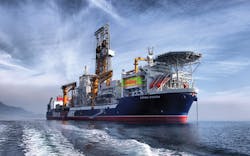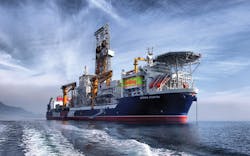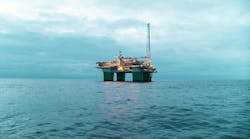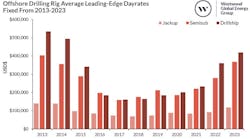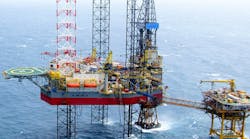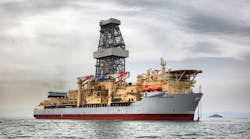Stena Forth to drill Jethro-Lobe offshore Guyana
The partners in the Orinduik block offshore Guyana have contracted the drillship Stena Forth for their first exploration well.
After completing its current program offshore West Africa, the rig is set to spud the well on the 250-MMbbl Jethro-Lobe prospect in June, close to and up-dip from numerous discoveries in the deepwater Stabroek block and in the same proven resource intervals.
The partners in the Orinduik block offshore Guyana have contracted the drillship Stena Forth for their first exploration well. (Courtesy Stena Drilling)
According to one of the block partners Eco (Atlantic) Oil and Gas, the agreement with contractor Stena also defines a window for a second well after Jethro-Lobe has been drilled.
Colin Kinley, Eco Atlantic’s COO, said: “While the Jethro-Lobe is a Tertiary target, which we believe is similar to the Exxon Hammerhead discovery that appears to extend onto Orinduik, we will also drill down to test the Cretaceous section below Jethro.”
Analyst sees uptick in exploration drilling, possible larger finds
Various offshore exploration wells planned this year could lead to ‘elephant’ finds, according to consultant Rystad Energy.
“Renewed optimism in exploration activities is anticipated in 2019, with operators from various segments aiming for multiple high-impact campaigns…in essentially all corners of the world,” said senior analyst Rohit Patel. “These include wells targeting large prospects, play openers, wells in frontier and emerging basins, and operator communicated high impact wells.”
Rystad’s new High Impact Wells Report lists the top wildcats to watch over the coming year.
Offshore Papua New Guinea, the Mailu-1 well will target a giant carbonate oil prospect which if successful, could open a new ultra-deep offshore play.
Eni’s Kekra-1 well is Pakistan’s first ultra-deepwater well in over a decade (potentially 1.5 Bbbl).
Dana Gas plans to make its debut as an offshore operator in the deepwater Egyptian sector of the Mediterranean with the Merak well.
Off Morocco, Chariot Oil & Gas’ Moh-B well will test a prospect that could hold 637 MMboe.
The Central Tano-1 well offshore Ghana will target up to 2.3 Bbbl of oil, while offshore Namibia, Total’s well on the Venus prospect will be the deepest anywhere to date offshore Africa, Rystad claimed.
Venus, also considered to be the largest prospect drilled so far off Namibia, is in a giant basin floor fan of the Orange basin.
West of Shetland, Hurricane Energy is set to drill a deepwater well on a prospect with a pre-drill estimate of 935 MMboe – the company is said to have indicated a 77% chance of success.
The Dunquin South well offshore western Ireland will pursue hydrocarbons in lower Cretaceous carbonate reservoirs in water depths of 1,500 m (4,921 ft). Here the pre-drill estimate is for up to 1.4 Bbbl of oil.
In the Gulf of Mexico, Total plans a well on the ultra-deepwater Etzil prospect, which has a 2.7 Bboe pre-drill resource estimate. Offshore French Guiana, the company is set to commit $114 million to drill the Nasua-1 ultra-deepwater well (1 Bboe pre-drill).
Finally, Shell will drill the Gato do Mato presalt prospect off Brazil, which the company bid for in the second presalt licensing round in 2017.
“In 2018 we saw that the decline in offshore exploration activity came to an end,” Patel said.
“The total number of offshore exploration wells last year was 325, compared to around 335 in 2017. For 2019 we expect that around 400 offshore exploration wells will be drilled.”
Transocean to upgrade five more semis with drilling automation
Transocean Ltd. has entered into an agreement with Equinor to license and install automated drilling control (ADC) systems on four high-specification, harsh-environment rigs currently on contract in Norway and a fifth semisubmersible that is expected to start operations in the Norwegian Sea this summer.
In 2017, the semisub Transocean Enabler was equipped with the ADC system and, the company said, has delivered tangible improvements in overall drilling efficiency that have led to more cost-effective wells for Equinor. Further, the system has demonstrated improvements in well integrity, while enhancing safety and operations assurance.
The upgraded floaters will include the Transocean Spitsbergen, Transocean Norge, Transocean Encourage, Transocean Equinox, and Transocean Endurance.
The ADC systems are developed through the combination of various technologies from MHWirth, NOV, and Sekal AS, which enable, among other things, higher rates of penetration while drilling, highly stable bottomhole pressures avoiding swab/surge effects and early detection of kick/loss events.
